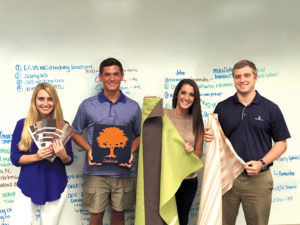Manufacturers are facing a variety of staffing challenges, and responding to the need to educate the public as well as potential employees about the benefits of a hands-on career.
It’s easy enough to understand that a lack of jobs can wreak havoc on economies, from local to global scales. What can be more complex is grasping how a plethora of opportunities in the manufacturing sector can also be something of an economic hindrance.

manager (outside sales, working with hospitality designers); and Matt Mitchell, supply chain analyst. “Zach has been in Phoenix learning how to be the general manager of one of our warehouses,” president
and CEO Dee Duncan says. “He is moving to Denver to continue his training with a lot more hands-on experience. Our goal is to turn him into a regional manager for operations.” Photo: Keyston Bros.
According to a 2015 report of The Manufacturing Institute, the United States alone will need to fill nearly 3.5 million manufacturing jobs over the next decade, of which 2 million could go unfilled. Two critical factors enter into the lopsided equation: (1) “loss of embedded knowledge due to movement of experienced workers”; and (2) “a negative image of the manufacturing industry among younger generations.”
The president of Inman, S.C.’s Inman Mills echoes the report based on his own company’s experience with 700 employees in three plants. “We have an aging workforce and fewer young people entering into manufacturing,” Norman Chapman says. “People are looking for more immediate gratification today and not at putting in the time that my generation and older generations are used to. They want my job very early in the process.
“With retirements, we are going to lose a tremendous amount of skill in the next five to 10 years,” Chapman continues. “Our biggest challenge is the transfer of knowledge.”
Even the smallest of companies can’t escape workforce gaps.
“Our staff of five, which includes my business partner and myself, range from 59 to 16 years of age,” says Owain Jones, co-owner of Hawkes Bay Trim and Canvas in Hastings, New Zealand. “We have had trouble finding suitable staff in the past and are lucky for those we have today. There is a shortage of tradesmen, let alone good ones, that are seeking a change in their work situation. This has left us putting in long hours to keep up with demand at times.”
It’s not as if the company hasn’t made a concerted effort.
“We have a program overseen by MITO,” Jones says, referring to the training organization serving New Zealand’s industrial textiles, transport and extractive industries. “This is where I and my business partner got our skills. I feel it is a huge part of ensuring that our trade continues to grow and does so in a way that keeps the same high standards that we were taught.”
IT’S COMPLICATED …
Jones understands how difficult it can be to strike a balance between embedded knowledge and fresh talent. “My business partner and I are in our 30s,” he says. “It has been daunting for us trying to find someone willing to work under a couple of younger guys. A lot of older tradesmen tend to be stuck in their ways. Hiring someone who is not willing to accept guidance or instruction on the way we want things done is not a good option.”
Australia’s Nolan Group—with almost 100 employees in six locations—deals with multiple workforce matters, including compliance with employment legislation.
“In the financial year 2015–16, we spent approximately$25,000onlegalandadvisory costs for employee-related matters,” says Chris Nolan, managing director of the Alexandria-based textiles distributor.
Among the staffing obstacles is what Nolan calls “relative remuneration.” “About half of the positions offered in our business are semi-skilled. There are industries that offer significantly better pay for these roles than what is common in the fabrics sector,” he explains. “A typical salary offered by us would be $60,000 (approximately $45,000 USD). But up to three times that would be offered by the mining sector at the height of the boom two years ago. Even now, at least double that is offered in the construction sector, which is experiencing strong growth.”
Dee Duncan, president and CEO of fabric distributor Keyston Bros. in Roswell, Ga., says that he continues to hear about two workforce concerns from those in the fabrics supply chain: “First, there is an issue with finding people who can sew. Second, the industry needs an influx of young professionals. There are a bunch of us that have been in this business for years, and having some fresh talent that can bring skills and technology would be a blessing.”
But respondents in a series of public perceptionsurveys(2009–2015) conducted by The Manufacturing Institute and Deloitte indicated a low opinion of manufacturing as a career choice.
“We have to change the public perception of our industry by better defining and projecting its proper image to the person in the street,” Nolan says. “Each company has to do this in its own right, and collectively through associations such as IFAI and its divisions. What our industry does is innovative, interesting and vital to the community. We have to use social media to systematically promote this message to the world at large.”
“The trade is not a very well-known one, and this probably needs to be addressed at a school level,” Jones says. “I’m sure, as time goes on and we continue trying to make contact with teachers in the textile education system, there will be a huge growth in young people taking an interest in what the many highly skilled people in our industry do and how we do it.
“We have looked for part timers in the shape of retirees, but haven’t had much luck with finding good ones,” he adds. “Many are quite happy working for themselves in the shed or, sadly, are no longer able to produce the quality and quantity of work we require.”
AT SCHOOL OR IN-HOUSE?
“I think a lot of schools are not presenting a path outside of a four-year degree,” Chapman says. “You can get technical training and make a very nice living without college debt. There are good careers in manufacturing, but I don’t think the average junior high or high school student is being told about those opportunities.”

Inman Mills takes the proactive approach of inviting guidance counselors, principals and teachers to visit. “We feed them lunch and give a presentation on our company and then do plant tours,” Chapman says. “We explain what someone coming into our operation can expect to do and to earn, and what their career progression can be.”
Through the process of identifying students who may not be interested in pursuing four-year degrees, Inman has developed an after-school apprenticeship program that has resulted in full-time hires upon students’ graduation.
Hawkes Bay Trim and Canvas has found success with apprentices from a boys’ high school and recently hired one full-time after a nine-month period during which the student worked at the company a couple of days a week.
“It was a fabulous arrangement,” Jones says. “We got a student looking for a career after school and trained him for nine months with no cost but our time. He had no idea what this trade had to offer, and was initially looking for a placement in joinery. It shows what potential our trade has when people are exposed to it.”
For the last three years, Keyston Bros. has been training paid interns through the Raymond J. Harbert College of Business Supply Management at Auburn University, and has hired all of them full-time upon graduation. Duncan says internships help students apply the knowledge they gain in school.
“Matt loves spreadsheets, and we taught him more about Excel,” Duncan says, by way of example. “He loves the purchasing aspect, but is using his knowledge to really dig into strategies of inventory. Zach loves to understand the systems flow of the warehouse and how to get merchandise to the customer in an efficient manner.”
“We have two approaches to recruitment,” Nolan says. “The first is to attempt to attract young, intelligent and enthusiastic people by offering to assist in their further education, such as by allowing time off to attend classes and/or by paying tuition fees in part or in full. We rotate them quickly through warehousing and customer service and expose them early to in-house management training. In this way, they have an opportunity to gain practical experience and a sound knowledge of how a business operates. They also get a clear idea of their opportunities for future progression.
“The second is to seek out people who are not necessarily as aspirant but are seeking stable employment. We encourage their ongoing loyalty by ensuring we have a cheerful and welcoming working environment.”
PULLING TOGETHER
As necessary, helpful and rewarding as it is, the mere act of providing guidance and instruction presents its own predicaments.
“It is a massive task simply to keep training curricula and manuals up to date,” Nolan says. “Furthermore, it’s inefficient to put one person through a formal induction process. And it is costly to bring people together from around the country to attend a training session. We are exploring joint training opportunities with our customers and suppliers, as many of the needs of our respective businesses and employees are common.”
“It is crucial for our business that we continue to up-skill ourselves and all our staff,” Jones says. “There are always new challenges coming in the door, and getting different people’s perspectives can be a great way to learn together.”
“Millennials love to work in teams. Understanding what makes them different helps you better manage them,” Duncan says. “We have been more deliberate in communicating with and involving them. The payoff is the enthusiasm, creativity and freshness they bring to a project. We are looking to the next generation to help solve problems today.”
Janice Kleinschmidt is a writer and magazine editor based in San Diego, Calif. For contact information on the sources used in this article, turn to page 74.
U.S. Department of Labor, Employment and Training Administration. Includes information and links for grants, state and local workforce investment boards and more.
WorkforceGPS (sponsored by the U.S. Department of Labor’s Employment and Training Administration). Includes downloadable reports, guides and tutorials.
Career One Stop (sponsored by the U.S. Department of Labor’s Employment and Training Administration). Provides links to finding state and local workforce development boards and contacts within them, local training schools/programs and industry data.
ApprenticeshipUSA (U.S. Department of Labor). Provides information on apprenticeship programs, case studies and the portal to register a program with the Department of Labor.
Jobs for the Future (national nonprofit that develops career pathways, educational resources and public policies to build a skilled workforce). Offers downloadable publications and a toolkit for developing work-based courses.
National Institute of Standards and Technology Manufacturing Extension Partnership. Provides location and contact information for Manufacturing Extension Partnership centers in all 50 states and Puerto Rico.

Jasmine Dheda (left) works as a medical textile technician in Taupo,
New Zealand, at Custom Technologies, which makes seating and other
components for wheelchairs. Photo: MITO New Zealand.
Though most training for new employees of Hawkes Bay Trim and Canvas takes place in-house, the company also relies on “block courses” held annually by the New Zealand government- and industry-funded organization MITO, which works alongside the Outdoor Fabric Products Association of New Zealand (OFPANZ) and offers certificates in canvas fabrication and motor trimming from three-year programs offered to those who have secured full-time employment.
“All companies face challenges associated with an aging workforce,” says Verna Naio, MITO’s group manager of workforce development. “Continued up-skilling and offering developmental opportunities will support them to keep pace with change.”
In the United States, Mary Ann Pacelli, program manager for workforce development at the National Institute of Standards and Technology, Manufacturing Extension Partnership in Gaithersburg, Md., recommends companies work with their local workforce investment boards and career centers. She adds that the U.S. Department of Labor offers funding to help companies train new employees, primarily through state block grants to workforce boards.
“Every state is different,” she says. “There could be funds available to retrain an existing workforce, called incumbent workforce training.” In any event, she suggests that companies interested in finding help with training start by connecting with their state workforce systems. She also mentions the recently implemented Advanced Functional Fabrics of America (AFFOA) in Cambridge, Mass.— one of eight Manufacturing Innovation Institutes established by the Revitalize American Manufacturing and Innovation Act of 2014. Six of the institutes, including AFFOA, are overseen by the Department of Defense (the other two are overseen by the Department of Energy).
AFFOA’s mission is to lead a domestic manufacturing-based revolution and transform traditional fibers, yarns and textiles into highly sophisticated and functionally integrated network systems. To ensure the success and longevity of its members, AFFOA is investing in education and workforce development and embarking on a thorough assessment of current, as well as future, workforce needs in the textiles industry.
“Our first task is to understand what models have been successful,” says Noah Lillian Drori, director of education and workforce development. “The needs in a situation where the same machines and processes are being used but new materials are going through them are completely different from the needs in a situation where there are new machines, new techniques and new technology considerations.
“Whatever training programs we support, we hope they will be part of a career pathway. We want to provide stackable credentials, building skills and growth within the industry,” she adds.
Inman Mills, Inman, S.C., is one of the industry members to join AFFOA in its early stages. “We know that we have got to do a better job of attracting employees, and that is one of the things AFFOA is doing,” says company president Norman Chapman.
In May 2017, AFFOA will open its prototyping Fabric Discovery Center, one of the goals of which is to bring together equipment and expertise for technology and manufacturing process development, as well as educational and workforce development.
Innovations in flexible materials and their incorporation into e-textile applications have expanded the marketplace for companies in the textiles supply chain. But traditional skills are as important as ever.
“The industry is in short supply of trained sewing machine operators, and many more are needed to support innovation,” says Magda Ronningen, IFAI Makers Program supervisor.
The Makers Coalition Foundation (businesses, educational institutions and nonprofits working together to find and train the next generation of industrial sewing operators to meet future demand) and the Industrial Fabrics Association International (IFAI) have partnered to strengthen the industry, train a new generation of sewers and create a workforce pipeline.
“Every company has the responsibility to train its employees in order to grow expertise within their business and within their industry,” Ronningen says, adding that internships, mentorship programs and other internal support for new employees are necessary investments to attract and retain workers.
“Replacing an aging workforce means adjustments by employers who need to address the Millennial mindset,” she says. “Millennials want to be part of something bigger than themselves and their own jobs.” Manufacturers in particular may have to get creative, she adds, to meet the expectations of a generation that wants scheduling flexibility to accommodate the demands of 21st century family life.
“This is one reason The Makers Industrial Sewing Training Curriculum includes industry expectations and good work habits to increase productivity,” she says.
Among early adopters is Tarrant County College in Fort Worth, Texas, which is using the curriculum for two upholstery courses and a fashion design course scheduled to begin in March 2017. “The foundation created the curriculum, and IFAI has added teaching support materials,” Ronningen says. “The goal is to build educational partnerships supported by regional networks of IFAI member companies.”
At the beginning of 2017, IFAI opened a jobs board on its website (www. ifai.com/jobboard/) to help connect members with young talent, and is building its online Small Business Center to create educational materials on how to start an internship program and guidelines for developing a good experience for the student.
"While all aspects of our trade will continue to embrace technology, it is important that we preserve and continue to teach the human, problem-solving part of this trade. It is vital for our industry that all apprentices and staff are taught the real craft and not just encouraged to push buttons or be a small part of a big chain."
Owain Jones
Co-owner
Hawkes Bay Trim and Canvas
"A good leader leads by example. We put our staff in positions to win—to achieve—to build their confidence. We mentor our new hires to ask questions, be thinkers and doers, and not be afraid to make a mistake. It gives employees a foundation upon which to build a career and a strong leadership style."
Dee Duncan
President/CEO
Keyston Bros.
"Technology advancement has considerable implications for future workforces. Industry will need to continue to be agile and evolve its skills and knowledge requirements. Integral to future proofing is an ongoing commitment to training emerging and existing talent."
Verna Naio
Group Manager Workforce Development
MITO New Zealand
 TEXTILES.ORG
TEXTILES.ORG


